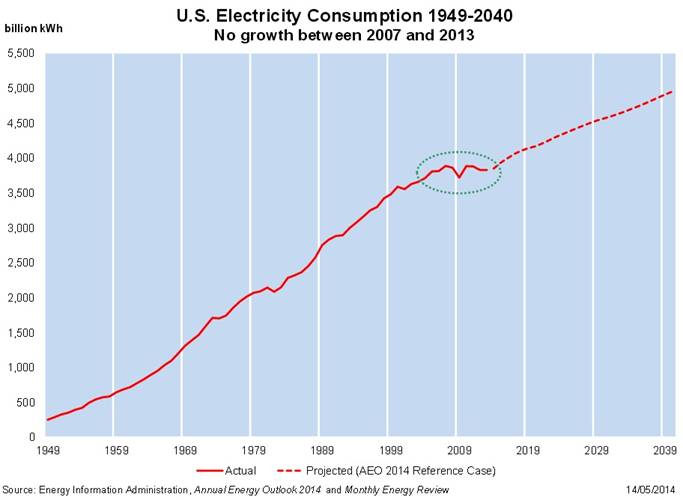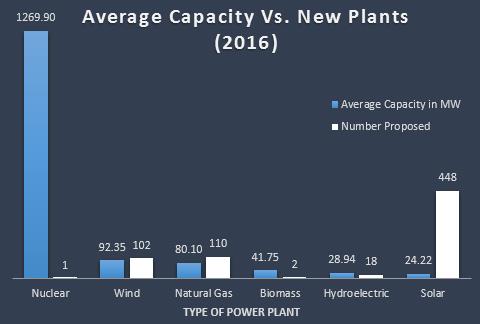
Figure 1: U.S. Energy Consumption over time [1]
[1]
Energy demand since the great recession of 2008 has largely remained stagnant, as indicated in figure 1. Many suggest various reasons for this anemic growth. Some reasons include a decrease in new construction and manufacturing, increased energy efficiency, young adults living at home etc. Given future outlooks, this may be subject to change, but many experts doubt there will be a large growth in energy demand here in the U.S. anytime soon. Rather, we should expect to see this demand slowly increase.
It's also important to note here that the U.S. experienced the most rapid growth in demand post WWII. This also coincides perfectly with the economic boom seen directly after the war's ending. It's no surprise that a country's energy demand strongly correlates with the economic ups and downs.
In a competitive environment, new power plants are only introduced to replace plants that are no longer viable because of ageing, because of fuel-cycle economics (for example, if the price of oil increases or if the efficiency of a new plant is increased) or to match increased demand. Some excess capacity is necessary to accommodate plant outages but idle capacity makes a utility non-competitive. Most new power plants in the U.S. are low in capacity, as illustrated below:

Figure 2: New plant capacity compared with the number of new plants built [2]
[2]
This figure shows the average capacity of each type of plant that came online in 2016, and the number of these plants that were finished in 2016. For wind mills and natural gas turbines, there are few economies of scale that would drive the plants to larger sizes. There is very little future potential for hydroelectric plants in the U.S. and it is extremely unlikely that there will be any future major hydroelectric projects, similar to the Hoover Dam. What stands out is that the only nuclear plant to come online had a larger capacity than all the other plants combined; however, wind, natural gas, and solar in their entirety had a higher share of overall capacity. What has driven the nuclear industry to large plant designs are the economies of scale such as associated with large turbine-generators and more efficient use of manpower per MWe. However, the upfront cost of a large nuclear plant is so large that financing represents a major barrier for the typical utility. Furthermore, the interest rates on loans for nuclear power plants are very high and, unless the public utility commission allows costs to be passed onto the consumer during the period of construction, return on investment is poor. But if there is one takeaway from this information, it's that utilities prefer to purchase smaller plants for new capacity. Therefore, at this time the market for new nuclear limits is intrinsically limited, since the only licensed designs by the NRC right now are large capacity designs. This doesn't completely mean that new nuclear isn't an option for utilities, but as it stands, it won't be overtaking any other source in the near future. Given utilities are favoring smaller, incremental increases in capacities, this opens the door for a new type of reactor, the small modular reactor (SMR).
Well-developed economies, like that of the U.S., are likely to see slow energy growth for a time period consistent with the planning horizon of utilities. Particularly in de-regulated states, any return on investment for a utility must occur quickly. Inevitably, as petroleum and natural gas resources become limited and more expensive, the transportation sector will move toward electrification but with improvements in hydrofracturing techniques in low short term costs that transition is likely to occur slowly over a period of decades. A financial commitment to large-scale plants is therefore unattractive for utility companies that are focused on short term payback. This applies to most countries with an established middle class. It makes sense to build large plants in places like China and India with very large populations, high growth rate of electricity demand and an extended time period of growth. This is why SMR's may make sense for countries with developed economies, such as the U.S. as well as for smaller countries with smaller grid size. NuScale's SMR design, for example, provides a utility with more flexibility in how much capacity they want to install, which is a very attractive feature of the design. One could also assume that smaller economies, like that of the UAE, could benefit from smaller reactors.
I personally foresee SMRs also being built in the developing world, after the learning curve of "First of a kind" construction is passed. A standardized, and factory fabricated SMR should be cost effective and attractive to a country looking to give power to its people. If developing and under developed countries embrace an SMR option for electricity, SMRs have the potential to help lift billions of people out of poverty, and sets its citizens on the course for a low emission, high quality of life. SMRs could be the future face of nuclear energy.
References
- http://www.worldenergynews.com/news/coal-falls-victim-stagnating-electricity-demand-604506
- https://www.eia.gov/electricity/data/eia860/index.html
- https://www.ferc.gov/market-oversight/mkt-electric/overview.asp



